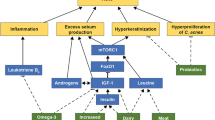Summary
An acneforme eruption was regularly induced in human adult male volunteers by topical application of corticosteroid solutions and various commercial creams. Within 7 to 14 days smooth, firm, dome-shaped, reddish papules of rather uniform size appeared followed by comedones several weeks later. Factors promoting the development of steroid acne were (I) high concentrations, (II) continuous occlusion, (III) young adults below age 30, (IV) whites in preference to blacks, (V) history or signs of acne, (VI) applications to acne areas of face and upper back. Increased formation of horny cells was demonstrated by radiolabelling with3H-thymidine,3H-glycine and3H-histidine. Histologically, the first event was a focal degeneration of the follicular epithelium with the formation of a circumscribed intra- and perifollicular abscess.
Zusammenfassung
Akneartige Efflorescenzen wurden regelmäßig bei männlichen erwachsenen Probanden durch Lokalapplikation von glucocorticosteroidhaltigen Lösungen und verschiedenen kommerziellen Fertigpräparaten erzeugt. Innerhalb von 7 bis 14 Tagen traten glatte, feste, kuppelförmige und entzündlich gerötete uniforme Papeln auf. Daraus entwickelten sich einige Wochen später Comedonen. Folgende Faktoren förderten die Ausbildung einer Steroid Acne: (I) der Gebrauch hochkonzentrierter Steroidzubereitungen, (II) eine fortlaufende Okklusivbehandlung, (III) ein Alter unter 30 Jahren, (IV) Kaukasier im Gegensatz zu Negern, und (V) die Anamnese einer durchgemachten oder noch persistierenden Acne vulgaris. Die Kinetik der Comedonenbildung wurde autoradiographisch mit3H-Thymidin,3H-Glycin und3H-Histidin verfolgt. Eine beschleunigte Hornzellbildung im oberen Follikelabschnitt wurde nachgewiesen. Histologisch war das früheste Ereignis eine umschriebene Spongiose und Nekrose im Follikelepithel mit nachfolgendem intra- und perifollikulärem Absceß.
Similar content being viewed by others
References
Blinstrub, R. S., Lehman, R., Sternberg, T. H., Straub, D. L.: A comparison of oral and intramuscular triamcinolone in the treatment of acne vulgaris. Curr. ther. Res.5, 414–421 (1963).
Cook, T. J., Lorincz, A. L.: Absence of steroid acne in children. Arch. Derm.89, 442–445 (1964).
Cope, C. L., Beardwell, C. B., Burke, C. W.: Urinary free cortisol determined by competitive protein binding. Abstract, 3rd International Congress of Endocrinology, Mexico, D. F., p. 107.
Cunliffe, W. J., Burton, J. L., Shuster, S.: The effect of local temperature variations on the sebum excretion rate Brit. J. Derm.83, 650–654 (1970).
Danto, J. L.: Effect of adrenocortical steroids on cystic and papular acne. J. invest. Derm.29, 315–318 (1957).
Dörner, W.: Erfahrungen über die Behandlung der Akne vulgaris mit Loticort®. Med. Welt41, 2341–2343 (1965).
Farber, E. M., Clairborne, E. R.: Acne conglobata. Use of cortisone and corticotropin in therapy. Calif. Med.81, 76–78 (1954).
Fisher, L. B., Maibach, H. I.: The effect of corticosteroids on human epidermal mitotic activity. Arch. Derm.103, 39–44 (1971).
Fulton, J. E., Kligman, A. M.: Aggravation of acne vulgaris by topical application of corticosteroids under occlusion. Cutis4, 1106–1108 (1968).
Martin, H.: Neuzeitliche Akne-Therapie. Z. Haut u. Geschl.-Kr.41, 69–71 (1966).
Murphy, B. E. P.: Some studies of the protein-binding of steroids and their application to the routine and ultramicro measurement of various steroids in body fluids by competitive protein-binding radioassay. J. clin. Endocr.27, 973–990 (1967).
Pascher, F., Kurtin, S., Andrade, R.: Assay of 0.2% fluocinolone acetonide cream for alopecia areata and totalis. Dermatologica (Basel)141, 193–202 (1970).
Plewig, G.: Zur Kinetik der Comedonen-Bildung bei Chloracne (Halowaxacne). Arch. klin. exp. Derm.238, 228–241 (1970).
Plewig, G., Fulton, J. E., Kligman, A. M.: Cellular dynamics of comedo formation in acne vulgaris. Arch. Derm. Forsch.241, 12–29 (1971).
Plewig, G., Kligman, A. M.: Zellkinetische Untersuchungen bei Kopfschuppenerkrankung (Pityriasis simplex capillitii). Arch. klin. exp. Derm.236, 406–421 (1970).
Plewig, G., Kligman, A. M.: Follikuläre Pusteln im Kaliumjodid-Epicutantest. Arch. Derm. Forsch.242, 137–152 (1972).
Raab, W.: Biochemisch-pharmakologische Betrachtungen zur äußerlichen Anwendung von Glucocorticoiden, allein oder zusammen mit antimikrobiellen Substanzen. Hautarzt22, 233–238 (1971).
Schöpf, E.: Nebenwirkungen externer Corticosteroidtherapie. Hautarzt23, 295–301 (1972).
Schuppener, H. J.: Zur Klinik und modernen Therapie der Akne. Erfahrungen mit einem neuen Anti-Akne-Mittel. Dtsch. med. J.17, 711–714 (1966).
Silber, R. H., Porter, C. E.: The determination of 17,21-dihydroxy-20-ketosteroids in urine and plasma. J. biol. Chem.210, 923–932 (1954).
van Scott, E. J.: Significance of changes in pilosebaceous units in acne and other diseases. In: The Human Integument. Ed. S. Rothman. Amer. Ass. Adv. Sci.54, 113–126 (1959).
Sullivan, M., Zeligman, I.: Acneform eruption due to corticotropin. Arch. Derm.73, 133–141 (1956).
Strauss, J. S., Kligman, A. M.: The pathologic dynamics of acne vulgaris. Arch. Derm.82, 779–790 (1960).
Strauss, J. S., Pochi, P. E.: The quantitative gravimetric determination of sebum production. J. invest. Derm.36, 293–298 (1961).
Tye, M. J.: Corticosteroid Topical Therapy pp. 227–240. In: Newer Views of Skin Diseases. Ed.: H. S. Yaffee. Boston: Little, Brown and Comp. 1966.
Tye, M. J., Fisher, B. K.: Acne treated with wet compress and a corticosteroid cream. Arch. Derm.87, 141–143 (1964).
Tye, M. J., Leibson, E.: Acne treated with wet compresses followed by corticosteroid cream. Ariz. Med.25, 38–41 (1968).
Weirich, E. G., Longauer, J.: Beeinflussung der epidermalen Proliferationsaktivität durch Corticoidexterna und deren Grundlagen. Arch. Derm. Forsch.241, 245–254 (1971).
Wexler, L.: Two controlled studies of a topical steroid preparation in the treatment of acne vulgaris. Appl. Ther.10, 455–457 (1968).
Author information
Authors and Affiliations
Rights and permissions
About this article
Cite this article
Plewig, G., Kligman, A.M. Induction of acne by topical steroids. Arch. Derm. Forsch. 247, 29–52 (1973). https://doi.org/10.1007/BF00595699
Received:
Issue Date:
DOI: https://doi.org/10.1007/BF00595699




